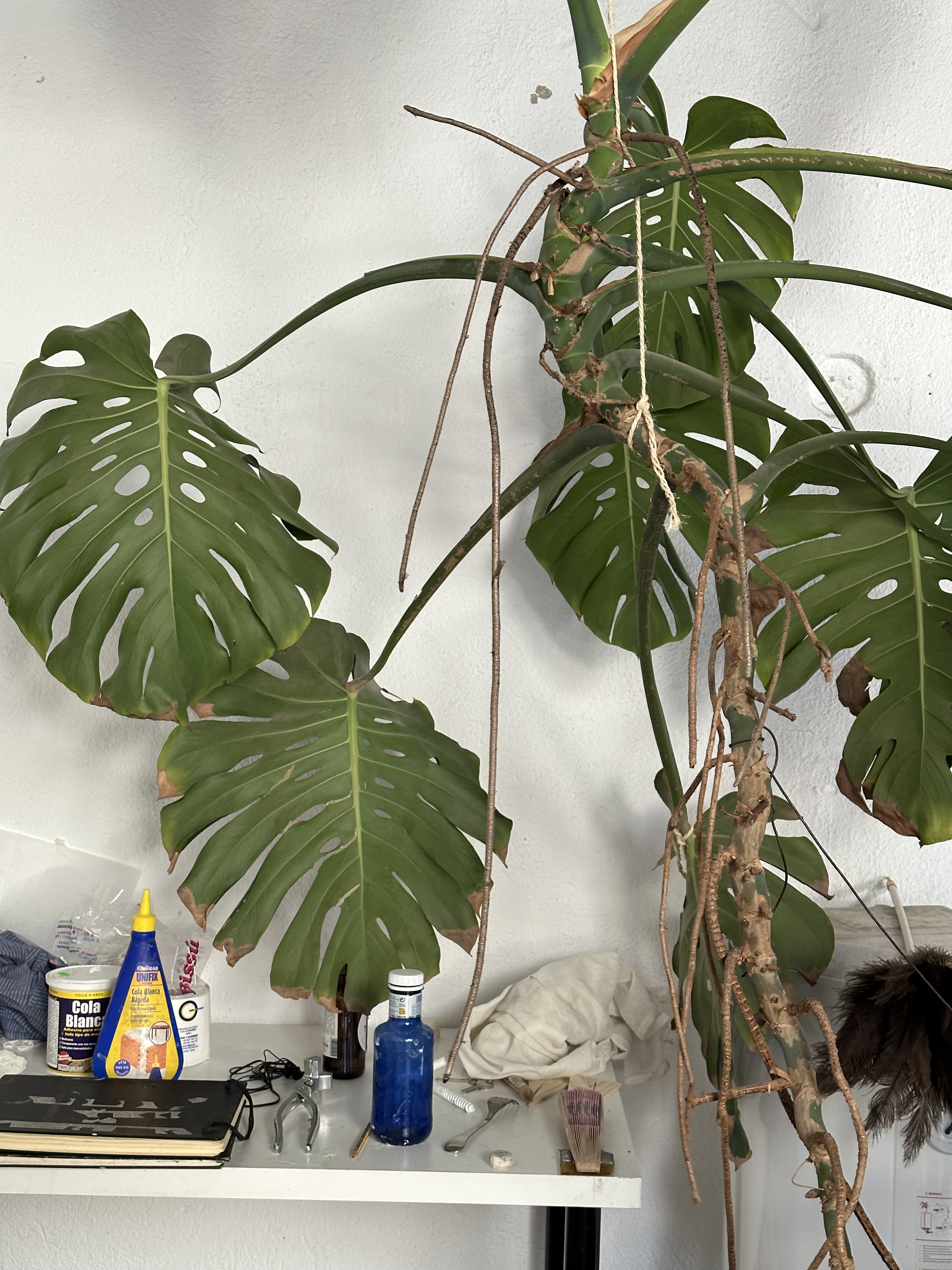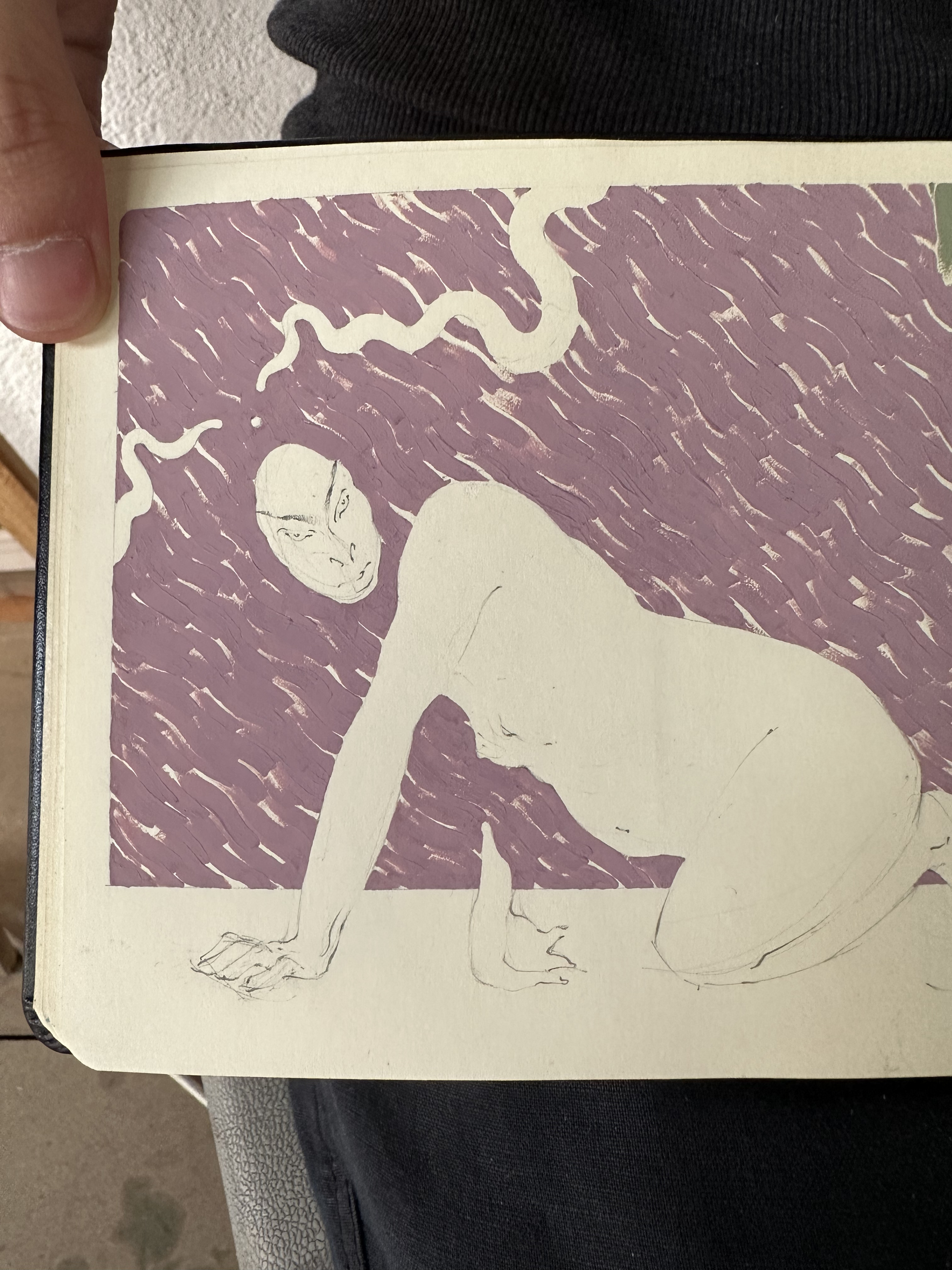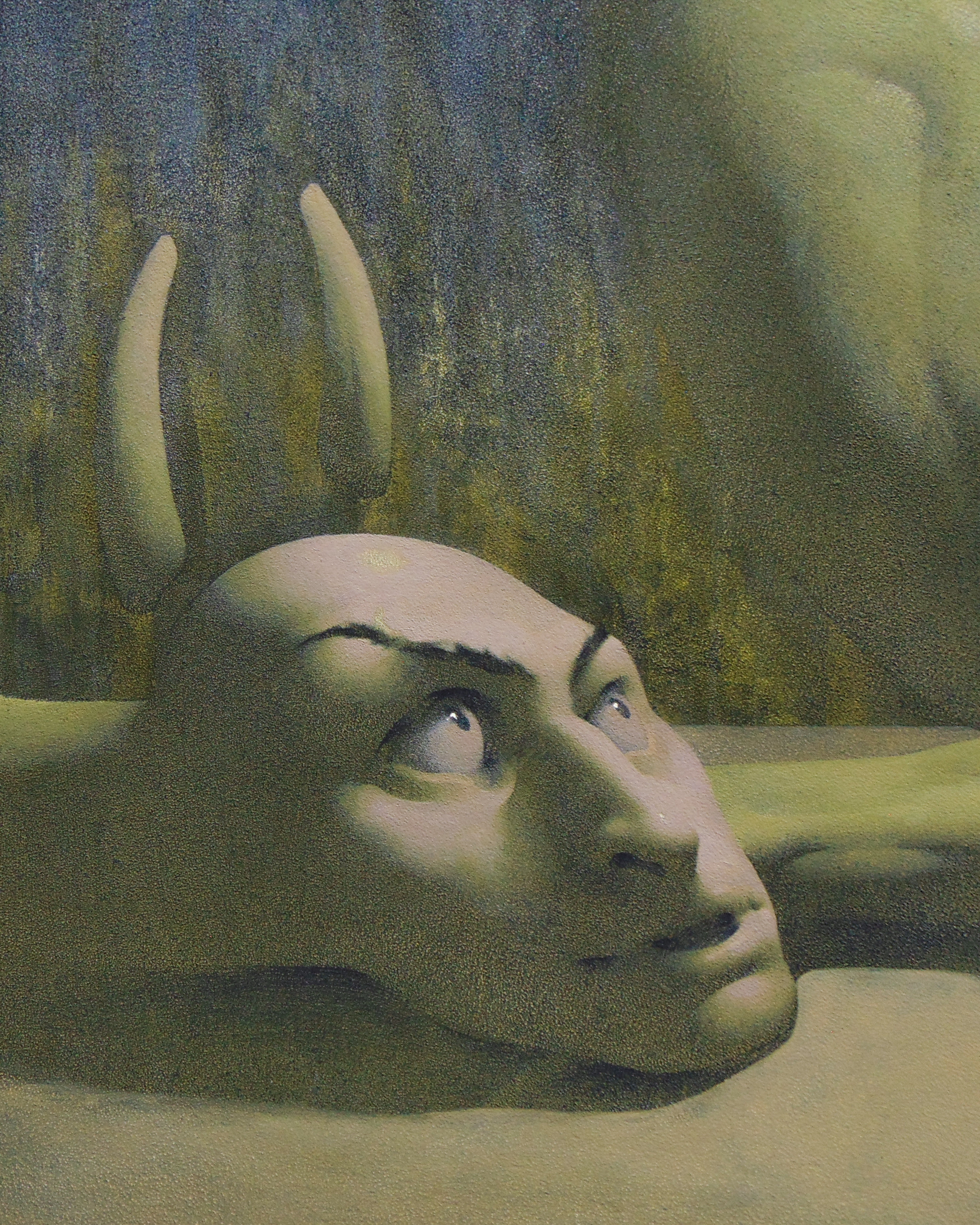Where to even start? Madrid-based artist Álvaro García is one of a kind. Baroque brushstrokes and a touch of sci-fi, packed with queer figures and even dragons isolated in a desertic space. Yes!
Coming from a background in Fine Arts at UCM, his career is as short as it has been meteoric. In 2021, he participated in a collective show at El Chico, and in June of 2023 he had in the same gallery his first individual show, “A strange face”, where I first saw his work. Days later, at his studio in the shared space of Casa Antillón, he explains to me that the gluey forms that populate his works emerge from the darkness, both literally and metaphorically, being rendered from shadowy layers and later illuminated. While he speaks, he shows me one sketchbook after the other, all brimming to the top with drawings, delineations, and scribbles of morphed faces and limbs. I feel like I'm in the presence of a kind of Renaissance genius, and I struggle to keep up with his quirky ideas. He hesitates to describe the blurry meaning of his creations - No, not symbols! Oh, I don’t know! I get the feeling that he sees his figures as fragments of himself: “I like to deprive them of individuality - to isolate them in space - to make them become somewhat alive.” As I observe these bizarre beings, I cannot help but feel that, even though they do not have a defined face, or a body, or an identity, their lonely, frail demeanor conveys something that I could recognize myself in. And I guess that’s what Álvaro’s painting is all about.
The best thing is to go see his work live. But, in any case, here are his crazy-yet-funny-yet-amazing replies.
When I decided to study Fine Arts, I wasn't sure of what I was going to encounter, nor was there even a specific discipline that interested me above the rest. I quickly discovered painting, which was what captivated me, and it's what I continue to do to this day.
Still, there were other disciplines that really left an impact on me, such as charcoal drawing and printmaking, for example. I believe that's where my interest in creating the atmospheres surrounding the figures in my paintings comes from. Another discipline I also enjoyed a lot was sculpture, particularly working with natural forms. I've been told before that my painting has a sculptural quality, and I think that aspect of my painting comes from there.
However, I believe that each discipline you explore ends up shaping you as an artist. I suppose that, for instance, photography can make you more observant; carving, more patient; theoretical or conceptual pursuits can lead you to question what you do more deeply, etc. Anyway, I think it's best to allow oneself to be constantly influenced by as many things as possible.

Your paintings have quite a classic air, although no one would doubt they have been created in the 21st century. Are you inspired by painters from other eras, contemporary artists...? What are your main references?
Oh, that is actually something I hear a lot. When I started painting in university, what intrigued me most was the ability to recreate the effect of light on the body, so I began to study a lot of classical painting. One thing I used to do was recreate other paintings or fragments of them in small formats, mostly from the Baroque or Romantic periods. I believe that's where the way bodies are illuminated in my works comes from, as well as the way the figures twist and contort within them, and sometimes even the way they are composed.
On the other hand, my imagery has been constructed (apart from the influence of some contemporary painters like Munch, the Symbolists, or Mucha) mostly through the consumption of images unrelated to painting. I'm fascinated by the Alien/Posthuman drag, as seen in Salvjiia or Anthr0pomoph, the films of Kaneto Shindo, and 90s anime, among other things. But what I think has influenced my work the most is illustration. Both the "Vintage" style, like that of Harry Clarke, and more contemporary examples like science fiction comics in the vein of Moebius. In fact, I recently bought the compilation of Little Nemo in Slumberland, and I'm completely amazed by it.

The first time I saw your works, before I met you, I thought that the person who had painted them had put a very intimate part of themselves into them. Their dreams, their ghosts... Do you aim to evoke this kind of reaction? Is painting a way for you to express and provoke emotions?
Oh, I've actually been in a bit of conflict about that too, because the idea of having something to express to the world can make me see myself as a bit of a narcissist. It's a bit like: “Who even cares!” But I suppose it's inevitable to infuse a part of yourself into your work, and mine specifically revolves purely around emotions, rather than ideas or concepts. Nevertheless, just like expressing emotions (which, as I understand it, involves simply revealing something you carry within so that it can be seen), I think my art is also about evoking them, and somewhat about wrestling with the world, by showcasing things I can feel myself, as well as the world around me. That's why the figures always carry a hint of monstrosity, vulnerability, fragility, and so on.

In the studio, you said a phrase that struck me: "The things I do - I want them to be alive in some way - I want the best for them." What do you mean by this? What makes your works "alive"?
Hahaha, oh, well, now it sounds a bit like a madman’s phrase. But yes, it's something I've been pondering for a while. Once a guy told me that the clouds in one of my paintings looked like characters, and, after thinking about it, I realized that I've always been a bit animistic. Not that I believe objects are literally alive, but I've somehow perceived them as entities, especially when I was young. I think that's why I arrange the objects in my paintings (trees, clouds, the moon, etc.) the way they appear and occupy the space they do, to give them the character of animated, living objects capable of affecting the person looking at them. That's what I mean by wanting a work to be alive, to impact the viewer with the same intensity as living things, or at least with the intensity of the three-dimensional world. Otherwise, it would be indifferent to anyone.
In my case, I find achieving this is somewhat easier because my paintings feature recognizable figures for the human eye. But I don't believe it's exclusive to this type of art. I suppose it's something all painters seek in their work because otherwise, why paint at all?

Despite the great detail in your paintings, the figures that appear in them have a somewhat undefined identity, without gender or profession, and sometimes almost without facial features. Why this ambiguity?
I believe there's always something in perception that leads us to assume the entirety of what we're confronted with due to certain visual characteristics it possesses.
In other words, for example, when we encounter a character wearing specific clothing or having a particular hairstyle, we tend to imagine them with a preconceived notion in our minds about what they are. We immediately assign an identity and a life to them, a narrative that only exists in our thoughts. This is an automatic mental exercise more than a conscious reflection, stemming from our body's instinct to seek "what it is" before "what its state is."
This is why I eliminate characteristics that could trigger an automatic narrative about a character. I reduce the figure to their facial and bodily expression, to the stiffness of their muscles and the softness of their skin. It's the simplest way I've found to achieve something akin to empathy or recognition of the other.

Another topic that intrigues me is the balance between planification and intuition in your work. Do your paintings start from an idea, an image, a feeling...? Do you let yourself get carried away whilst drawing, or do you have a clear idea of what you want to represent before putting pencil to paper and starting the first sketch?
All my paintings start from the pencil drawings I create in sketchbooks. When I face the blank canvas, I always do so without knowing what I'm going to create. Most of the time, I begin by drawing a circle and a couple of lines from which a face emerges, then a body, and sometimes it's accompanied by a background and other elements or figures. All of this is intuitive, without a preconceived mental image. The only thing I have, aside from a certain automatization in drawing, are the emotions that accompany me in that moment.
The process of painting, however, is quite different. When I transition from the sketchbook to the canvas, a mental image of how the painting should be emerges, along with a plan. This is what I have to wrestle with while I paint. If I make a mistake and the painting stops working, I have to let go of that mental image in order to reorganize myself. And even though this is an essential aspect of painting, I'm quite stubborn, hahaha.
Why do the figures that populate your paintings always appear so small in scale, isolated in a large space?
Well, this has to do with two things. On one hand, it's related to the characteristics of the surfaces I use, which give me a grainy effect that I utilize to enhance the texture of the skin. The figures can't exceed the size of the grain in proportion, or else I lose that effect.
The other reason, which I realized relatively recently, is connected to the relationship in size between the viewer and the figure. If I paint them life-sized, it seems like these figures, which always contain something unsettling, are lunging at the viewer. Quite a violent impression. However, if I slightly reduce their size, the interaction becomes more intimate and endearing, neutralizing the effect to some extent. I think it's about finding that middle ground where neither the figure engulfs the viewer nor the viewer engulfs the figure. It's to ensure that the relationship between them remains balanced and the channel formed between the two stays open.
I'm also curious about the space that surrounds the figures, always quite undefined. Where are these beings located?
It's curious, because the environment in which the figures exist has evolved over time, yet it has always remained quite indefinite. Initially, they were situated in a place resembling a desert with dunes and mountains, devoid of any life. Later, in my sketchbook, landscapes with trees emerged, almost merging with the figures themselves, yet resembling screens or backdrops. In my recent works, the space has condensed into a vanishing point, a world resembling some sort of limbo.
Now that I reflect on it, I think the desert might relate to a place where the encounter between two entities becomes more intense due to isolation (it's important to note that, in these works, the figures are always accompanied).
As for the landscapes with trees, to be honest, I'm still uncertain about their significance. Lastly, regarding the limbo, I'm certain it's a way of materializing the mind, where the figures that appear are facets of the same entity.
Let's talk about technique. How do you achieve such detailed figuration? What role does light play in your painting? In the studio, you told me interesting things about layers, grisaille, chiaroscuro...
It all originates from when I began drawing in university. There, I was taught to use charcoal in a way that, by smudging the paper, an atmosphere would emerge from which I could then extract light accents using cloth. This approach led me to comprehend light, on a physical level, as an accident that, when it interacts with a mixture of matter, can reveal things by making them distinct from one another. This is what I translated into my painting when I started working on my own.
That's why, when I paint, I always begin by constructing the shadowed area with layers of transparency, overlaying various colors. I give this initial stage a function akin to that of a grisaille, but reversed, as I then bring out the areas that are affected by direct light over it, layering more impastoed oil layers to define the figures. Afterwards, when these layers are dry, to finish, I refine the color using very thin transparencies, which, in a way, immerse the light areas back into the atmosphere created by the grisaille.
 In your first solo exhibition, "Una Cara Extraña" (2023), you created a series of paintings that all have something in common. You decided to repeat a set of elements: a face, a figure, a little dragon... Have you attributed a specific meaning to each of them? Can you tell us more about it?
In your first solo exhibition, "Una Cara Extraña" (2023), you created a series of paintings that all have something in common. You decided to repeat a set of elements: a face, a figure, a little dragon... Have you attributed a specific meaning to each of them? Can you tell us more about it?Yes, the series of paintings that formed the exhibition were centered around these three entities. The "being" is one of the figures that often populate my paintings, and the other two emerged in my sketchbook this past year.
One of them is the "strange face”, which resembles a Japanese mask and undergoes transformations throughout the exhibition. Well, it's actually more accurate to say that it mutates its body or adapts it. It often occupies the space of a negative presence, as if it appears for something bad to happen, if it's not already happening. On the other hand, there's the figure of the dragon-sphinx with a human face, which, although it might have a threatening presence, represents something neutral to me.
However, concerning the specific meanings these figures might hold, I prefer not to say too much, as it's been a short time, and I myself don't have a clear understanding yet. Furthermore, I don't want to overly influence the viewer and cloud the mystery they might evoke.

You’ve said several times that you are a "baby in art": let's see what happens when you come of age! What are your expectations? How do you think your painting will evolve in the future?
Hahaha, yes, I am! It’s actually because I really just started my career, and that's why I think it's challenging for me to think about my long-term expectations; it makes me quite anxious. However, in the short term, I have some ideas of where I want to go.
On one hand, I want to break away from the strict steps I follow when painting in layers, something I already did for 'A Strange Face,' and it yielded interesting results. Specifically, I want to start using transparencies to build up the light areas and see what possibilities it offers. I also want to explore larger formats, which is a challenge for me due to the size of my figures. So, maybe a few of them will start appearing in a single painting.
On the other hand, new things are emerging in my sketchbook. Faces are starting to have pupils, and the figures are becoming more distinct from each other. Gradually, new entities similar to the strange face and the dragon-sphinx are appearing, and I think my imaginative world will head in that direction.
Overall, I believe my painting will become more blurred, focusing more on transparent color, the brushstroke, and their own languages rather than purely realistic representation. Or rather, how these two aspects integrate. But, of course, stating this is always a bit risky as you can quickly discover something unexpected that changes your direction. I suppose that's painting, a path full of surprises…
Interview by Whataboutvic. 18.10.2023











